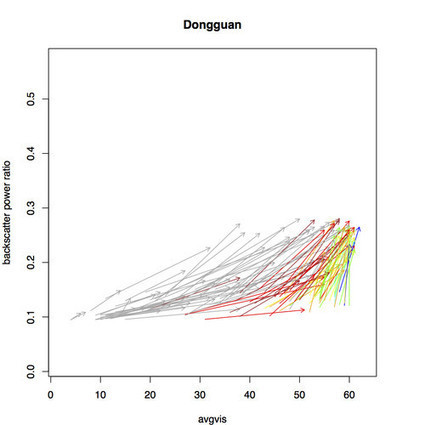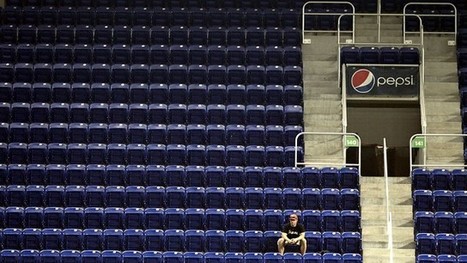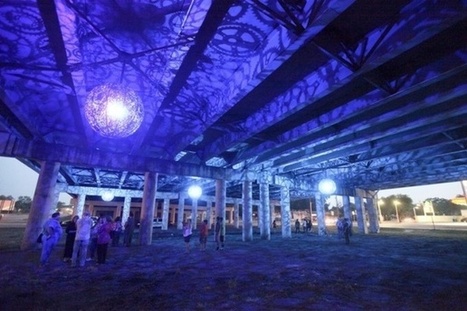 Your new post is loading...
 Your new post is loading...
Born of the desire to swim in new york city's rivers, '+pool', the world's first floating water-filtering aquatic facility, will be the largest publicly funded civic project ever. Three new yorkers have worked with international engineering and design firms such as ARUP to create '+pool', the world's first recreational floating aquatic filtering facility. The layered structure is designed to purify river water, over a half million gallons daily. Composed of four sections forming the '+', the program is designed to accommodate everyone -- children and adults, athletes and bathers alike. the project is finished 'tile by tile', where each block is inscribed with a name or personal message of a sponsor or group of sponsors who donate over 25 USD.
Via Lauren Moss
Faced with the incomprehensible scale of worldwide mega-urbanization, observers have alternately fallen back on sheer numbers or city comparisons to drive home the speed at which cities in the developing world are growing.
A number of design firms have drawn up plans for new a Penn Station and Madison Square Garden as part of campaign to rebuild the complex. Renowned studios SHoP Architects, Skidmore, Owings & Merrill (SOM), Diller Scofidio + Renfro, and H3 were all asked to re-imagine the New York landmarks by the Municipal Art Society (MAS), a nonprofit that campaigns for, among other things, intelligent urban design and planning. The most radical proposals came from Diller Sofidio + Renfro and SOM, who both submitted wildly complex designs. Their proposal, "Penn Station 3.0" aims to serve "commuters, office workers, fabricators, shoppers, foodies, culture seekers, and urban explorers," with a multi-level complex that's topped by a rooftop public garden. The concept separates out the fast-moving commuters, who are confined to the lowest level, and adds layers of stores, cafes, a spa, and even a theatre, in which people are able to move around at a more leisurely pace. The plan would also see Madison Square Garden relocate to sit alongside the Farley building on 8th Avenue. Find more information at the complete article.
Via Lauren Moss
Despite improvements in air quality, four in 10 Americans still live where pollution levels are often dangerous to breathe. There is no doubt that great strides have been made in air pollution in the U.S. Awareness, stricter legislation and improved technology have all contributed to improved air, land and water conditions. Despite the improvements, four in 10 Americans still live where pollution levels are often dangerous to breathe. Since the American Lung Association began studying particle pollution, almost all of the most polluted cities have consistently remained among the worst. The ALA’s 2013 “State of the Air” report measures cities based on low-lying ozone pollution, as well as both short- and long-term particle pollution. Based on average long-term particle pollution figures collected between 2009 and 2011, 24/7 Wall St. identified the 10 most polluted cities in the country...
Via Lauren Moss
About half a block from Marlins Park, a hunchbacked stadium in Miami's Little Havana neighborhood, a scalper named Shorty spoke in a stage whisper. "Need a single?" he asked. I did. "Give me 10 bucks," Shorty said, cupping a crumpled ticket in his hand. Under normal circumstances, a scalper has the advantage in these encounters. Shorty would have massaged the market for that night's Mets-Marlins game before I even showed up. But I knew all about the Marlins. I knew they had the worst record in baseball. I knew Marlins Park had become an ocean of empty blue seats. I knew Giancarlo (né Mike) Stanton, the only superstar left after the Marlins' clearance sales, had strained his right hamstring the night before and was out for weeks. Stanton was being replaced in the lineup by a guy named Marcell Ozuna, who jumped straight from Double-A. Ten bucks? I must have looked skeptical, because Shorty played up the illicitness of our transaction. He pulled me into a parking garage. "There's a cop over there," he said. Let the cop come, I thought. If baseball tickets were narcotics, this thing in his hand would count as "trace amounts." It had next to no value.
The city’s emergency manger called for a complete restructuring of the city’s finances and described long-term obligations of at least $15 billion.In a report to be presented to Michigan’s treasurer on Monday, Kevyn D. Orr, the emergency managerappointed in March to take over operations here, described long-term obligations of at least $15 billion, unsustainable cash flow shortages and miserably low credit ratings that make it difficult to borrow.
Best City Parks In The US: 10 Relaxing Green Spaces For A Little Urban Zen
Huffington Post
... the City by the Bay so livable.
Santiago Chile announced they’re going to become a “smart city” in 2013, and is just one example of a growing number of areas around the globe preparing and modernizing for the future. In fact demographers have long predicted the mass urbanization of metropolitan areas across the world. According to the United Nations, by the year 2050, 80% of the world will be living in urban areas. The equivalent of seven Manhattan size cities will be built each year until 2050. For these cities to thrive they must use smart technology to its fullest. Let’s take a look at what’s available now and what’s coming down the pipe...
Via Lauren Moss
The comeback of the urban core is a striking reversal of long-term trends. But America’s ongoing urban comeback is far from complete.
Government investments in Toronto's waterfront deliver strong economic returns Canada NewsWire (press release) "The tri-government effort to revitalize our waterfront is an increasingly important driver for economic development in Toronto," said...
The Atlantic Cities Class-Divided Cities: Houston Edition The Atlantic Cities But in keeping with the postmodern, hopscotch nature of Houston's urban redevelopment, Project Row Houses, a community-based nonprofit art and cultural organization, is...
There are now over 300 cleantech companies in the city, as well as more than 10 biotech companies, Lee said. The city’s “mid-market” area is booming, with Dolby Stereo planting its headquarters on the 1200 block of Market, Square placing its HQ on 11th and Market, as well as Twitter, Zoosk, Yammer, Zendesk and others also setting up shop.
When technology changes at the speed of a microprocessor or the flicker of a screen, in the time it takes to type in a password or hit send on an email, how can buildings be created to contain all this light-speed innovation? That is the quandry confronting the architects designing Cornell and Technion University’s news campus on Roosevelt Island. “Google didn’t exist 25 years ago, Facebook didn’t exist 25 years ago, even AOL didn’t exist 25 years ago,” Andrew Winters said on a recent afternoon. The director of capital projects and planning for Cornell NYC Tech, he was giving a preview of the the school’s proposed Roosevelt Island campus in a large conference room inside the Wall Street offices of SOM, the master planners for the 12.5-acre project. Thom Mayne, the Pritzker Prize-winning L.A. architect designing the first academic building on the campus was also present, along with a number of other Cornell construction executives. “The challenge,” Mr. Winters continued, “is how do you create a tech campus today that is still flexible enough to grow and evolve for the next 25 years?”
|
We often talk colloquially about the "fast pace of city living," and that pace actually has a default speed: We’ve long assumed that people cross the street walking at about 4 feet per second. Crosswalks are timed with this number in mind, so you don't get clipped by a creeping car when the red hand starts flashing at you midway through an intersection. But the older we get, the more likely we are to slow down. Most 80-year-olds just don’t move at 4 feet per second. This bit of infrastructure trivia wasn't all that relevant just a few decades ago. "In the '60s, a majority of people weren't living past 70, or 75," says Hilde Waerstad, a physical therapist and research associate with the MIT AgeLab. As the vast baby boom generation now prepares to age well beyond 75, the demographics of entire cities will effectively age, too. "We're entering into this new era," Waerstad says, "that we just have not seen before."
From a solar mansion in China to a floating farm in New York, green buildings are sprouting up in cities around the world. Among their many benefits are curbing fossil-fuel use and reducing the urban heat island effect.
The Science Barge is a floating environmental education classroom and greenhouse on the Hudson River in New York. Fueled by solar power, wind, and biofuels, the barge, which was built in 2007, has zero carbon emissions. Vegetables are grown hydroponically in an effort to preserve natural resources and adapt to urban environments, where healthy soil, or soil at all, is hard to come by. Rainwater and treated river water are used for irrigation. The owner of the barge—New York Sun Works—designed it as a prototype for closed-loop and self-sufficient rooftop gardens in urban areas. Visit the link for more examples of green urban projects and intiatives...
Via Lauren Moss
A conversation with the Arizona-based duo behind San Antonio's "Ballroom Luminoso," among other projects... Joe O'Connell and Blessing Hancock are two Arizona-based artists who specialize in public art. But they're not the type to build your standard metal sculpture on a public plaza. The duo operates a 14,000-square-foot fabrication facility in Tucson with 14 other artists, designers, engineers and craftspeople, making art out of fabricated metal, acrylic materials, LED lighting, and electronics. Looking to find new ways for people to live and interact with art, O'Connell and Hancock create design pieces that help define the space they occupy and encourage interactivity. Their most recent project, "Ballroom Luminoso," debuted earlier this year under an elevated highway in San Antonio. Part of a neighborhood improvement plan, the project aims, through design, to bridge the physical boundary created by the I-10 highway, forming better connections between the different ethnicities and income levels in the area.
Via Lauren Moss
“More than eight in 10 neighborhoods across the United States fall into the two least bikeable categories. And more than half of them — 3500 plus — are concentrated in very bottom category. Conversely, just 3.2 percent of the neighborhoods make the top-ranked category, Biker’s Paradise, while another 14.6 percent can be considered Very Bikeable.”
In honor of Bike to Work Day, Richard Florida takes a look at America’s most bike friendly cities and neighborhoods using Walk Score’s bikeability rankings. Bike commuting may be on the rise in the United States, but the country is still far from being a Biker’s paradise.
Resilience is the word of the decade, as sustainability was in previous decades. No doubt, our view of the kind and quality of cities we as societies want to build will continue to evolve and inspire a new descriptive goal. Surely we have not lost our desire for sustainable cities, with footprints we can globally and locally afford, even though our focus has rightly been on resilience, after what seems like a relentless drum beat of natural disasters around the world. It speaks to the question: what is the city we want to create in the future? What is the city in which we want to live? Certainly that city is sustainable, since we want our cities to balance consumption and inputs to make a footprint that can last into the future. Certainly it is resilient, so our cities are still in existence after the next 100-year storm, now apparently due every few years. And yet: as we build this vision we know that cities must also be livable. Indeed, we must view livability as the third indispensible—and arguably most important—leg supporting the cities of our dreams: resilient + sustainable + livable.
Via Lauren Moss
You may or may not have seen the news that according to Movoto, the top 10 most exciting cities include SF and Oakland, but it’s Oakland that takes grand prize. Movoto defends the list, explaining the 10 criteria surveyed in defining “exciting”: Park acreage per personPercent of population between 20 and 34 years oldFast food restaurants per square mile (the fewer the better)Bars per square mileBig box stores per square mile (the fewer the better)Population diversityMovie theaters per square mileMuseums per square mileTheater companies per square mileMusic venues per square mile The calculations were made based on the individual city proper and its size, excluding suburbs or nearby cities (not covering an entire metro). The result? Some surprises, maybe, for New Yorkers or San Franciscans, since neither made number one. Instead, Oakland did. What’s happening with real estate in Oakland? The Chronicle has covered in depth the woes of renters who find rents inflating all over the Bay, including Oakland where once “deals” could be found. In plain numbers, according to SocketSite, “Over in Oakland, the average monthly rent is up 14.6 percent year-over-year to $1,947 per month while down in San Jose it’s $1,873 per month, up 8 percent year-over-year.” Real estate values, meanwhile, are also on the rise. These data from Redfin show the performance of condos in Oakland through the last two years, with a marked upward trend on prices in the still young 2013. (And Oakland made news last August for enjoying the fastest selling homes in the nation.)
Daily Beast
What's Killing the Gas Station?
Daily Beast
Some, like the BP in Soho and the stations on Wisconsin Avenue in Bethesda, are victims of high land values in bustling urban and suburban cores.
Adrian Smith + Gordon Gill Architecture, dedicated to sustainable architecture, has imagined and designed city so compact that nothing is more than a 15-minute walk away. Dubbed “Great City,” the prototype suggests a Chinese city that might be built in 2021 on the outskirts of Chengdu, a city in the southwest of Asia. Taking up just 1.3 square miles and 320 acres, Great City could be home to 80,000 people. The project proposes that 15 per cent of the total acreage would be devoted to urban parks and green areas, 60 per cent to buildings and 25 per cent to roads and walkways. To design the world’s first pedestrian-only city, the architects considered a massive transit centre where public transport would be concentrated...
Via Lauren Moss
The World's Top 20 Cycling Cities
The Atlantic Cities
Amsterdam and Copenhagen are the top cities for cyclers, according to the latest Copenhagenize Index.
Happiest Cities For Young Professionals: Forbes - Huffington Post Huffington Post Linscheid says San Francisco's diverse culture, unique character and lively neighborhoods make the city a top visitor destination and a “leading urban center...
ABC News
Old Guard Sees Threat in Youthful NJ...
This past summer, New York’s Department of City Planning put forth a plan to rezone 78 blocks of East Midtown centered around Grand Central Terminal, making room for a bevy of new towers from the projected next great Manhattan build-out. Pitched as a strategy to bolster New York amidst imminent international competition, the East Midtown Study inspired both the thrill and fear of large scale change: Could New York enhance its skyline and increase its density without losing its soul? Would Midtown become another run-of-the-mill central business district, a globalized landscape of glitzy, glass-skinned stalagmites crushing the layers of history below? Perhaps to palliate our worst Kafka-esque architectural nightmares, the city invited three renowned architecture firms, WXY Architecture + Urban Design, Skidmore Owings & Merrill (SOM), and Foster + Partners, to imagine “the next 100 years” of Grand Central Station (which is fast approaching its 100th birthday) and the surrounding Midtown cityscape.
Via Lauren Moss
|



 Your new post is loading...
Your new post is loading...

































